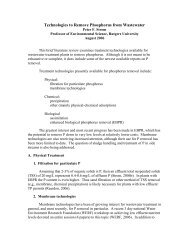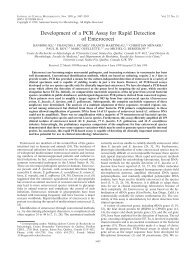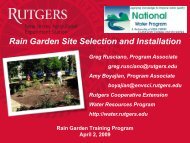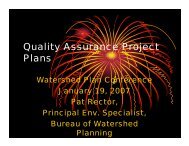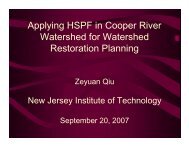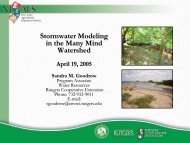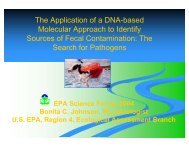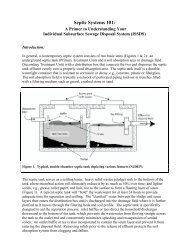Onsite Wastewater Treatment Systems: Alternative Technologies
Onsite Wastewater Treatment Systems: Alternative Technologies
Onsite Wastewater Treatment Systems: Alternative Technologies
Create successful ePaper yourself
Turn your PDF publications into a flip-book with our unique Google optimized e-Paper software.
Fact sheetFS530For a comprehensive list of our publications visit www.rcre.rutgers.edu<strong>Onsite</strong> <strong>Wastewater</strong> <strong>Treatment</strong> <strong>Systems</strong>:<strong>Alternative</strong> <strong>Technologies</strong>Christopher C. Obropta, Ph.D., Extension Specialist in Water Resources & David Berry, Student in Bioresource EngineeringIntroductionA typical <strong>Onsite</strong> <strong>Wastewater</strong> <strong>Treatment</strong> System (OWTS)consists of a septic tank and a soil absorption field thatallows treated effluent to infiltrate into the soil. Whenfunctioning, these systems are effective at removing pollutantsbefore they enter into the environment.However, it has been determined that due to geologicaland hydrological conditions, 2/3 of the U.S. is unsuitablefor septic systems (USEPA, 2002). Costly system failuresand the release of pollutants may result if a septicsystem is improperly sited. Fortunately, many alternativetechnologies have been developed for situations whereconventional systems are not appropriate.<strong>Treatment</strong> Units1. Aerobic <strong>Treatment</strong> UnitIn an Aerobic <strong>Treatment</strong> Unit (ATU) (Figure 1), wastewaterenters a compartment where solids settle and arepartially digested by microorganisms. A motor pumps airinto the chamber and mixes the liquid, facilitating diffusionof air and supporting aerobic bacteria that furtherdegrade the wastewater. The treated effluent exits theATU for additional treatment and dispersion through asoil absorption field.<strong>Wastewater</strong>From HouseEffluent to Advanced<strong>Treatment</strong> orAbsoption FieldAdvantages: ATUs can reduce the total suspended solidsand biochemical oxygen demand. A reduction in suspendedsolids improves the efficiency and life of the soilabsorption field.Disadvantages: ATUs require electricity and have movingparts, requiring frequent inspection and high equipmentreplacement costs.Purchase Cost: The cost of an ATU is between $3,500and $10,000.Operation and Maintenance Cost: Operation andmaintenance costs average between $500 and $700 peryear. This includes the cost of electricity to run the airpump and regular inspection costs.2. Fixed-Activated Sludge <strong>Treatment</strong>Fixed-Activated Sludge <strong>Treatment</strong> (FAST) systems aresimilar to aerobic treatment units that fit inside preexistingseptic tanks (Figure 2). The wastewater cyclesbetween the oxygenated FAST system and the septic tank.This recycling action causes microorganisms to convertammonia and nitrates into nitrogen gas, an inert andabundant atmospheric gas. Because the FAST unit featuresrecycling of effluent, it is more effective than asingle-pass ATU at removing ammonia and nitrates.<strong>Wastewater</strong>From HouseRecycled<strong>Wastewater</strong>FAST UnitPumpedAirEffluent to Advanced<strong>Treatment</strong> orAbsoption FieldSeptic TankMediaFilterTreated EffluentAir BubblesFAST Unit<strong>Wastewater</strong> InletFigure 1. ATU Schematic (Schematic courtesy of David Berry)Figure 2. FAST System Schematic (Schematic courtesy ofDavid Berry)
Advantages: The FAST system is particularly efficient atammonia and nitrate removal.Disadvantages: The FAST unit uses electricity and requiresoccasional maintenance of the motor.Purchase Cost: A FAST unit costs about $5,000. Aproperly sized septic tank costs about $2,000.Operation and Maintenance Cost: Typical costs areapproximately $300 per year. This amount includeselectricity and regular inspection costs.3. Recirculating Sand FilterThe Recirculating Sand Filter (RSF) utilizes an additionaltreatment stage beyond the conventional septic system(Figure 3). Effluent from the septic tank is pressurizedand sprayed on a volume of sand. Microorganisms breakdown organic matter and convert ammonia into nitrate asthe effluent filters through the sand. When the effluentreaches the under drain, a portion of the water enters thesoil absorption field and the rest re-circulates through theseptic tank, where the nitrates are converted into nitrogengas, an inert gas that can be vented to the atmosphere.Septic TankPump Chamber4/5 FlowSandSprayNozzlesSand FilterUnderdrainLeachingFacility1/5 FlowFigure 3. RSF Schematic (Massachusetts DEP, 1997)Advantages: Recirculating sand filters are extremelyefficient at reducing biochemical oxygen demand, totalsuspended solids, and ammonia and nitrate levels in arelatively small area.Disadvantages: Frequent inspection and maintenance isrequired to ensure proper functioning.Purchase Cost: The costs of an RSF are variable, dependingupon the cost of the sand media. An estimate isbetween $10,000 and $15,000.Operation and Maintenance Cost: $200 to $300 peryear, including electricity. The system must be inspectedand occasionally the top layer of sand must be removedfor optimal performance.4. Trickling FilterIn trickling filters (Figure 4), also known as fixed-filmreactors, microorganisms typically grow on a speciallydesigned synthetic material, such as a plastic polymer,instead of being carried with the liquid, as in a typicalseptic system.InfluentSepticTankFigure 4. Trickling Filter Schematic (Massachusetts DEP,1997)Advantages: Trickling filters can handle surges of flowto the system without losing the microbial communityresponsible for effluent treatment. They are extremelyeffective at reducing biochemical oxygen demand.Disadvantages: Trickling filters must be used as anadvanced treatment in conjunction with the septic tank.Purchase Cost: Equipment is about $9,000 includinginstallation.Operation and Maintenance Cost: Approximately$200 to $300 per year. The unit must be inspectedregularly by a professional.5. Sequencing Batch ReactorThe sequencing batch reactor (SBR) is particularly successfulat the removal of nitrate, phosphorus, and ammonia.The design principle consists of a series of processesthat occur in sequence in a single underground unit(Figure 5). During the treatment cycle no additionalinfluent is allowed to enter the unit.Septic TankOptional recirculation of effluentFixedfilmreactorOptional sludge returnClarifierSequenchingBatchReactorPump TankFigure 5. SBR Schematic (City of Austin, 2001)Effluent2
Advantages: Efficient removal of nitrate, phosphorus,and ammonia.Disadvantages: This technology requires professionaloperation and maintenance, so a contract with a licensedcompany is highly recommended.Purchase Cost: The cost of equipment and installation isabout $8,500 to $12,000Operation and Maintenance Cost: Yearly maintenancecosts are on average $250 to $400. This includes electricity,inspections, and pumping.Soil Absorption <strong>Systems</strong>1. Mound SystemMound systems (Figure 6) are so prevalent they are notconsidered an “alternative” technology. They are appropriatefor areas with a high water table or shallow bedrock.A septic tank or alternative system first treats the wastewater.The liquid then flows into a storage compartment,where it is pumped up to a leach field within a soil mounda few feet above grade. The mound provides an adequatevolume of unsaturated soil to treat the wastewater thatexits the perforated pipe network in the leach field. Thecost of a mound system is highly variable, depending inlarge part on the cost of the transport of the appropriatesoil mixture to the construction site.<strong>Wastewater</strong>From HouseSeptic TankSoil AbsorptionPipe NetworkDosing Tank andHydraulic PumpVegetation(Grass)Sand MoundFigure 6. Mound System Schematic (Schematic courtesy ofDavid Berry)Advantages: The mound system performs well in areaswith high water tables or shallow bedrock.Disadvantages: Installation is expensive and the moundcan be visually and physically obtrusive.Purchase Cost: A mound system costs approximately$25,000 to install.Operation and Maintenance Cost: About $100 per year.This cost includes electricity and regular inspections.2. Subsurface Drip SystemDrip systems (Figure 7) feature small diameter plastic pipingwith effluent emitters. The piping network runs througha system of shallow trenches. Effluent is pumped intermittentlyto the pipes for slow infiltration into the soil.<strong>Wastewater</strong>From HouseFigure 7. Drip System Schematic (Schematic courtesy ofDavid Berry)Advantages: Drip irrigation is ideal in hilly, rocky conditionswhere there is little space for soil absorption. Italso avoids mound necessity.Disadvantages: It is important that the effluent has beenfiltered of solids that could potentially clog the piping.The effluent should be treated to an advanced level so thatit is safe for shallow land application.Purchase Cost: Approximately $15,000 including thepumps, valves, and control units.Operation and Maintenance Cost: The annual fee foran operation and maintenance contract is approximately$500. This covers inspections and regular maintenance.Electricity usage will add a small additional cost.3. Peat FieldSeptic TankAdvanced<strong>Treatment</strong>Dosing Tank andHydraulic PumpSubsurface Small DiameterDrip Infiltration SystemA peat leach field, which is usually in a contained unit, isvery similar in design to a conventional leach field. Themain difference is that effluent drips through a layer ofpeat before entering the soil. This has been shown toimprove the quality of effluent by reducing total solidsand nitrate levels. Because peat is a natural substance, thecomposition of it is extremely variable. Peat that is to beused for onsite treatment must have certain characteristicsto make it an efficient filter, such as proper moisturecontent and preparation.Advantages: Peat is relatively simple to install andmaintain, and delivers a high quality effluent.Disadvantages: It is important that the system be builtcorrectly and with the right materials because if improperlyinstalled peat systems may clog.Purchase Cost: Installation of the peat field is approximately$10,000.3
Operation and Maintenance Cost: About $100 per yearfor electricity and for pump maintenance.ConclusionMany of these technologies are considered to be experimentalin New Jersey at this time. Therefore, a NewJersey Department of Environmental Protection(NJDEP) <strong>Treatment</strong> Works approval is required. ContactNJDEP at 609-292-0407 for more informationFor More InformationRutgers Cooperative Research & Extensionwww.rcre.rutgers.eduU.S. Environmental Protection Agencyhttp://cfpub.epa.gov/owm/septic/home.cfm andwww.epa.gov/etv/verifications/vcenter9-3.htmlNSF Internationalwww.nsf.org/business/wastewater_treatment/index.asp?program=<strong>Wastewater</strong><strong>Treatment</strong>UnitsA Compendium of Information on <strong>Alternative</strong> <strong>Onsite</strong>Septic System Technology in Massachusettswww.state.nj.us/dep/dwq/pdf/compend.pdfReferencesCity of Austin <strong>Onsite</strong> <strong>Wastewater</strong> <strong>Treatment</strong> and DisposalFact Sheets. 2001. Austin, Texas.www.ci.austin.tx.us/wri/fact.htm.Massachusetts Department of Environmental Protection(DEP). 1997. A Compendium of Information on <strong>Alternative</strong><strong>Onsite</strong> Septic System Technology in Massachusetts.www.state.nj.us/dep/dwq/pdf/compend.pdf.U.S. Environmental Protection Agency (USEPA). 2002.Manual: <strong>Onsite</strong> <strong>Wastewater</strong> <strong>Treatment</strong> <strong>Systems</strong>Manual. EPA/625/R-00/008. Office of Research andDevelopment. Cincinnati, OH.A Partial List of New Jersey Suppliersand Installers(The inclusion of these companies does not indicate anendorsement by Rutgers University; it is merely providedas a reference tool.)A-L Septic ServicesL.J. Rusciani Assoc., Inc.Vineland, NJBerlin, NJPhone: (856) 691-3433 Phone: (609) 767-2323Aquapoint, Inc.Manchester Septic Tank Co.New Bedford, MAFreehold, NJPhone: (508) 998-7577 x17 Phone: (732) 761-9540Arthur Stanley Septic Montville Septic ServiceBurlington, NJBoonton, NJPhone: (609) 386-9814 Phone: (973) 334-4800Ashco-A-Corporation Septic Restoration <strong>Systems</strong>Morgantown, WVSparta, NJPhone: (304) 291-0808 Phone: (973) 729-8549Bio-Microbics, Inc.Septic System ServicesShawnee, KSWharton, NJPhone: (800) 753-3278 Phone: (973) 361-0181Central Jersey Septic Inc.Old Bridge, NJPhone: (732) 525-0040Cromaglass CorporationWilliamsport, PAPhone: (570) 326-3396Ewing Septic <strong>Systems</strong>Cape May, NJPhone: (609) 884-3312F.R. Mahony & Assoc., Inc.Rockland, MAPhone: (781) 982-9300South Jersey Bio-SepticSupply Co.Elmer, NJPhone: (856) 358-4771Sweetrose Septic Corp.Andover, NJPhone: (973) 347-3878Tri-County Septic ServiceNewton, NJPhone: (973) 579-2751Mention or display of a trademark, proprietary product, orfirm in text or figures does not constitute an endorsementby Rutgers Cooperative Research & Extension and doesnot imply approval to the exclusion of other suitable productsor firms.© 2005 by Rutgers Cooperative Research & Extension, (NJAES,) Rutgers, The State University of New Jersey.Desktop publishing by Rutgers–Cook College Resource Center Published: January 2005RUTGERS COOPERATIVE RESEARCH & EXTENSIONN.J. AGRICULTURAL EXPERIMENT STATIONRUTGERS, THE STATE UNIVERSITY OF NEW JERSEYNEW BRUNSWICKDistributed in cooperation with U.S. Department of Agriculture in furtherance of the Acts of Congress on May 8 and June 30, 1914. Rutgers Cooperative Research & Extensionworks in agriculture, family and community health sciences, and 4-H youth development. Dr. Karyn Malinowski, Director of Extension. Rutgers Cooperative Research & Extensionprovides information and educational services to all people without regard to race, color, national origin, gender, religion, age, disability, political beliefs, sexual orientation, ormarital or family status. (Not all prohibited bases apply to all programs.) Rutgers Cooperative Research & Extension is an Equal Opportunity Program Provider and Employer.



